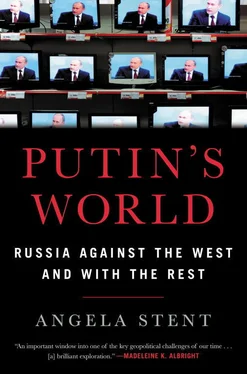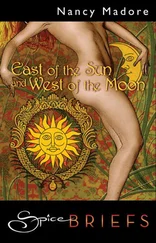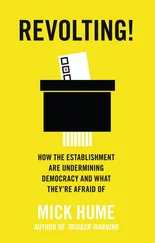A brief period of greater autonomy for the Cossack Hetmanate ended after Peter the Great defeated the Swedes in 1709 at the Battle of Poltava, declared himself emperor in 1721, and renamed the tsardom of Muscovy the Russian Empire, thus signaling the rise of Russia as a major European power. Those Ukrainians living under Russian rule were gradually absorbed into the Russian imperial system and Cossack self-governing units were abolished. Russians began to call Ukrainians “little Russians.” In 1768, Catherine the Great went to war with the Ottoman Empire, and for the first time, Russia gained control over what is today’s Donbas region in Southeastern Ukraine, the territory seized by Russian-supported separatists in 2014. Catherine called these lands, which included the Port of Odessa, Novorossiya (New Russia). Russia also conquered Crimea for the first time. The peninsula had been under Ottoman rule, and its inhabitants were Muslim Crimean Tatars.
Catherine the Great’s lover, Prince Grigory Potemkin, who administered these newly acquired territories, persuaded the tsarina that she should visit her new conquests. In 1787, she set out from Saint Petersburg on a six-month trip to Sevastopol in Crimea, covering more than 4,000 miles by land and water. Potemkin, realizing that the trip had to be flawless, arranged for all the roofs in villages she passed on the Dnieper River to be freshly painted, the streets freshly paved, giving rise to the legend of “Potemkin villages,” or “false fronts covering a gloomy reality.” 10Catherine was gratified as she traversed the new lands of Ukraine. A wilderness was waiting to be developed, and Potemkin planned cities on the Black Sea, attracted foreign colonists to settle in them, and began to create the fleet that would be his legacy.
As Russia was conquering Southeastern Ukraine, the Polish-Lithuanian Commonwealth began to break apart, ending in 1772 with the first of three partitions of Poland. Those Ukrainians living in Galicia were now ruled from Vienna and were called Ruthenians in most of the Austro-Hungarian Empire and Rusyns in the Transcarpathia region. By 1795, ethnic Ukrainians were divided between Dnieper Ukraine under the Russian tsars—where 85 percent of them lived—and Austria-Hungary. The social and cultural development of ethnic Ukrainians between the late eighteenth century and the Bolshevik Revolution diverged widely. Galician Ukrainians in Western Ukraine preserved their language and customs more than those Dnieper Ukrainians under imperial Russian rule in the east. They began to develop a distinct national consciousness, participating in the revolutions of 1848 and declaring their autonomy. For the next half century this consciousness grew. In imperial Russia, by contrast, there was little effective political activity on behalf of ethnic Ukrainians, nor was the Ukrainian language well developed. Most Russians did not consider Ukrainians a separate ethnicity. After the 1905 revolution, the first Ukrainian-language journal appeared in Kyiv, and a group of Ukrainians gained a few dozen seats in the new Duma, where they tried to promote Ukrainian causes. But the tsar soon dissolved the Duma and put an end to these endeavors.
REVOLUTION, WAR, FAMINE, AND WAR AGAIN
Vladimir Lenin promised the non-Russian ethnic groups living in the empire that, if the revolution came, they would achieve independence. In March 1917, after the tsar’s abdication, representatives of Ukrainian political and cultural organizations in Kyiv composed a coordinating body, the Central Rada. The revolution came in October 1917, and the Ukrainians took Lenin at his word. Following the Bolshevik coup, the Rada proclaimed the Ukrainian People’s Republic and in January 1918 declared Ukraine’s independence. Thus began Ukraine’s second, brief period of independence from Russia during the chaotic post-revolutionary period and the civil war. The collapse of the Austro-Hungarian Army and ensuing Russo-Polish War also reunited Dnieper and Galician Ukrainians and led to the proclamation of an independent Ukrainian state of former Russian-and Austrian-ruled parts of the country in 1919. But the collapse of the Austro-Hungarian Empire also created a new, independent Polish state.
As the Russo-Polish War intensified, Lenin’s long-term goal of world revolution was subordinated to the imperatives of military victory over the Poles. Without Ukrainian bread and coal, that would be very difficult. Ukraine’s rich black earth and abundant grain supplies were indispensable for Russian victory. In 1920, the Poles defeated the Russians and seized lands the fledgling Ukrainian state had sought to incorporate. By the terms of the March 1921 Treaty of Riga, Poland took back Galicia, and Ukraine was once again divided—this time between Russia, Romania, Poland, and Czechoslovakia. The question of why Poland and Czechoslovakia were able to achieve independence after 1918, while Ukraine was not, is partly answered by the weakness of the Ukrainian national movement and the different historical trajectories of Galician and Dnieper Ukraine. 11
Under Stalin’s rule, Soviet Ukraine experienced a brief cultural renaissance—with increased use of the Ukrainian language in educational institutions. This was soon followed by a dark decade of famine and violence during collectivization and the purges. When Stalin began his campaign of forced collectivization of the Soviet countryside, and many peasants throughout the USSR burned their crops and slaughtered their livestock in acts of resistance against being herded onto collective farms, the regime singled out Ukraine for especially harsh treatment. Between 1932 and 1934, increasingly unrealistic grain requisition quotas were levied on Ukrainian peasants. Altogether, close to four million people in the Ukrainian Soviet Socialist Republic perished as a result of the ensuing famine. 12Ukrainians refer to this man-made famine as the Holodomor, a premeditated act of genocide during which Stalin deliberately targeted Ukrainians for elimination. Many Russians dispute this narrative, claiming that Stalin was essentially an equal-opportunity killer and that there were Soviet-made famines in other parts of the Soviet Union during collectivization.
Ukrainians had barely recovered from the famine and Stalin’s purges when Germany invaded Poland under the secret terms of the 1939 Molotov-Ribbentrop Pact, followed shortly thereafter by the USSR invading Eastern Poland and acquiring the Galician Ukrainian population. In June 1941, Hitler scrapped his agreement with Stalin, launched Operation Barbarossa, and invaded the USSR—through Belarus and Ukraine. Ukraine was, for the Nazis, the ultimate Lebensraum (living space), a territory where racially pure Germans could escape from the “unhealthy urban society” and build a racially pure society. This meant, of course, removing the local Slavic population, who they considered Untermenschen (subhumans). The Reichskommissar for Ukraine, Erich Koch, was a particularly brutal leader. 13Nevertheless, given many Ukrainians’ antipathy toward Soviet rule, some of them initially welcomed the Nazi invaders as liberators and collaborated with them. This, plus the fact that one of their nationalist leaders, Stepan Bandera, initially allied his organization with the Nazis, has fueled the current Russian narrative about “Ukrainian fascists” running the government in Kyiv. Other Ukrainians joined the resistance to the Nazis. By the time Lieutenant-General Nikita Khrushchev led Red Army troops to recapture Kyiv in November 1943, Bandera and others had grown disillusioned with the Germans.
The territorial settlement at the end of World War Two reunited Galicia and Dnieper Ukraine in the new Ukrainian Soviet Socialist Republic. Stalin had managed to secure Roosevelt’s assent to allow Ukraine to have its own delegation at the United Nations, which gave it international status. His successor, Nikita Khrushchev, in a seeming act of generosity, made that decision in 1954 whose consequences he could not possibly have foreseen. In honor of the 300th anniversary of the Treaty of Pereiaslav, and celebrating the “great and indissoluble friendship” of the Russian and Ukrainian people, he transferred Crimea from Russian to Ukrainian jurisdiction, making it part of the Ukrainian Soviet Socialist Republic. 14At that point Khrushchev was involved in an ongoing power struggle and he wanted to improve his support among Ukrainian elites. He did this not just for symbolism and sentiment but also for practical economic reasons, hoping that Ukraine was in a better geographic position to help Crimea’s struggling economy. After all, Ukraine and Crimea were connected by land, whereas Russia had no access by land to Crimea. 15
Читать дальше












